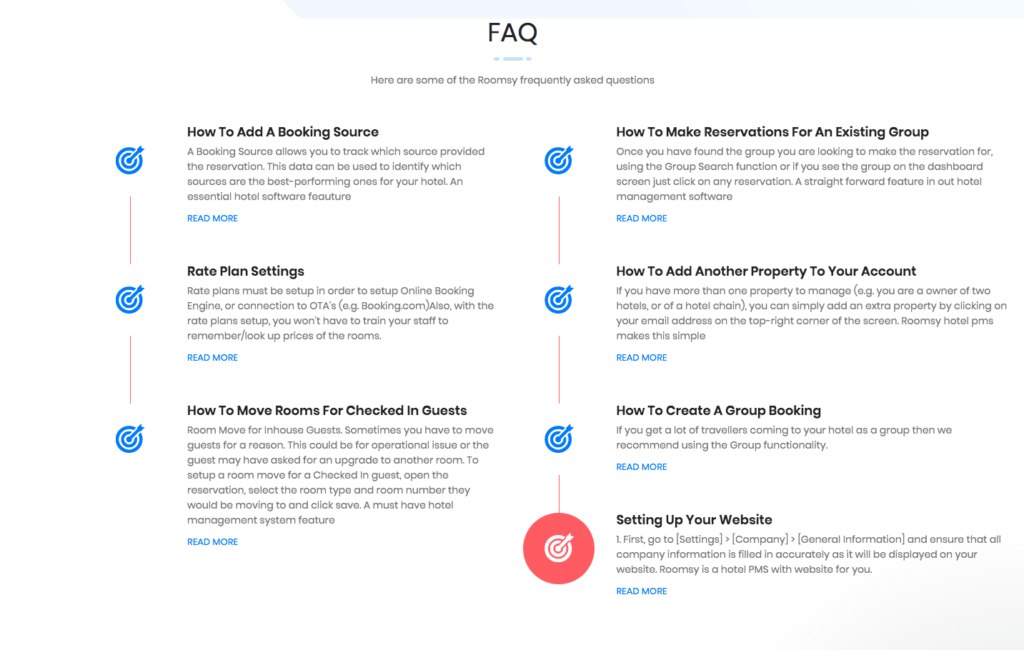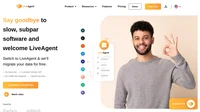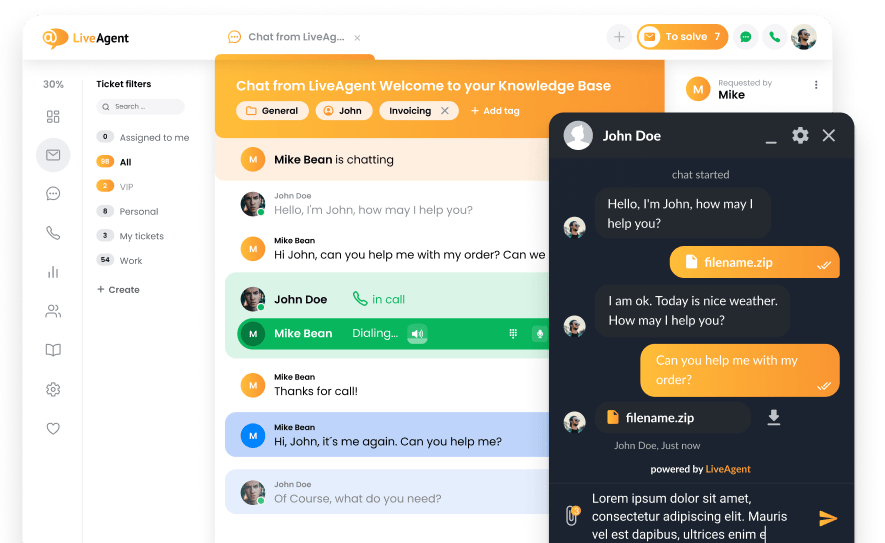With an increasing number of consumers preferring self-service options over traditional customer support channels, having a solid, smartly structured FAQ page design has become a must-have element of almost any business website. According to Forrester’s research, FAQs are the most frequently used self-service options available today.
When used strategically, a FAQ page design can truly add value to consumers and benefit businesses in many different ways. It’s not only one of the most efficient and cost-effective ways to reduce the burden on support teams by handling those repetitive questions about your products or services that otherwise might go to your customer support agents, taking up their time unnecessarily. FAQs can also improve your site navigation, overall SEO, and enhance the customer experience.
Fortunately, creating and maintaining FAQs has become easier with the help of FAQ builder software. With this tool, businesses can easily create a knowledge base that is visually appealing and highly informative to customers. It’s a great way to save time and resources for businesses while providing customers with quick and accurate solutions to their queries.
What is FAQ?
FAQ (stands for Frequently Asked Questions) is a section of a company’s website dedicated to answering customers’ most common questions and concerns. FAQ pages aim to make finding answers easy for customers, ideally without any need for outside assistance from a company’s representative. For e-commerce businesses, FAQs mostly cover the company’s rules and policies about order changes, payments, shipping, returns, and refunds. For SaaS businesses, FAQ’s page design mainly serves to guide customers on installing, using the product and troubleshooting common issues.

The difference between FAQs and knowledge base
Basically, FAQs differ from knowledgebase articles in size, content, and approach. FAQs are presented in a question and answer format and are intended to be short, direct, and straight to the point. They typically answer questions in a couple of sentences or paragraphs, while knowledgebase consists of instruction-type articles giving users more detailed and in-depth information on using the company’s products or services.
How to design an effective FAQ page in 7 steps
Writing a FAQ page involves more than just answering the most asked questions. It’s an opportunity to build relationships with current and potential customers and ensure better customer satisfaction. When creating FAQ page design, keep the following tips, strategies, and best practices in mind;
1. Identify relevant questions
The key to building an effective FAQ page is finding and answering real questions that your customers have. These questions can be found from a variety of sources such as your;
- Site-search data
- Emails
- Support tickets
- Website’s feedback form
- Customer surveys
- Comments on your social media pages
- Product reviews for your items
- Competitors’ FAQ page design
Inventing questions for the sake of answering them might only create customer frustration. Make sure they are relevant to your target audience and match real concerns your customers and prospects have.
2. Build a well-organized structure
If there are only a few questions to answer, put them in a single list. For longer lists of questions, it makes sense to break them down into common categories. Thus, providing a better user experience and ensuring that visitors are able to; easily navigate the page and find what they are looking for.
The questions can be grouped under such categories as ‘General Information‘, Using the Product’, ‘Account Management’, ‘Troubleshooting’, ‘Security’, ‘Billing’ etc. It’s recommended to order questions within each category from the most to the least frequent.
3. Watch out the framing of your questions
Write questions from a customer’s perspective, i.e. in the first person. Consider the following questions: ‘How can I integrate your product with my CRM system?’ and ‘How does your product integrate with a CRM system?’ Though both ask the same question. The first option is more customer-centered as it matches with how a user actually thinks. On the other hand, the second one is more business-centered. Therefore, when framing questions, use formats like: ‘What are my …’, ‘How do I …’, ‘Can I …’ etc.
4. Be short, clear and concise
When writing FAQs make sure the questions are clearly and simply worded. The answers should focus solely on giving the information required. Avoid providing any extra or unnecessary details that might distract a reader’s attention. The lengthier the content, the harder it is to keep the users interested in reading it. If a question requires a long answer, consider covering only the basics. After that, link it further to your knowledgebase article or a blog post that provides more detailed information.
5. Ensure easy readability
Since FAQ page design is generally text-based, easy readability is important. Whatever the audience, write in a language they understand. Furthermore, refrain from jargon, acronyms and technical terms your users may not be familiar with. Avoid using any unnecessary design elements that can draw readers away from your page’s content. Stick with a simple layout, an easy-to-read typeface, and an appropriate contrast. To ensure better readability you can also distinguish questions from answers by color, size, or style.
6. Provide visual elements
Many consumers prefer a FAQ page design that presents answers visually. Adding visuals that supplement your answers is a great way to make your FAQ page look appealing, unique, and valuable. Those visuals could include screenshots of a user interface demonstrating certain processes on your website. Such as resetting passwords, changing account information, canceling orders, making returns. Moreover, flowcharts, how-to videos guiding customers through common tasks. Make sure any visual element that you add is aimed at making your answer more accurate. Thus, easily understandable for the readers.
7. Keep the content up to date
A static FAQ page can quickly become outdated. You should regularly revise and update the FAQ page design to ensure the content stays relevant and helpful to customers and prospects. As your business is facing changes, and whenever new customer concerns come up and new questions arise; you should review and adjust your FAQ pages accordingly. Therefore, they reflect those changes and to ensure that all the answers are accurate, and the questions remain relevant. It is also advisable to evaluate the answers occasionally and rewrite them to be clearer if needed. If you keep getting the same question on your FAQ page over and over again; it’s a sign that the answer isn’t making sense to your audience and needs to be rewritten.
BONUS
We have created a couple of FAQ templates to inspire you. Simply copy and paste and get started!
Discover on your own
Knowledge is important, but only when it’s put into practice. Test out Customer Portal right inside of LiveAgent.

Try out LiveAgent for FREE
Handle all customer inquiries from one interface. Start improving your customer service with a 30-day free trial right away!
Frequently Asked Questions
How do you write a good FAQ?
Writing a good FAQ involves careful consideration of the most common questions and concerns that users may have about a product, service, or topic. It's important to anticipate what information users will need and provide clear, concise answers. Additionally, it's helpful to organize the FAQ in a logical and easily navigable format, such as categorizing questions by topic or relevance. Including examples, visuals, and links to more detailed information can also enhance the effectiveness of a FAQ. Lastly, regularly updating and revising the FAQ based on user feedback and evolving information is key to maintaining its usefulness.
How many questions should be on an FAQ page?
The number of FAQ page questions varies, considering the information complexity and user queries. Aim for comprehensive information to address user concerns without overwhelming navigation. Guidelines suggest around 10-20 questions, but adjust as needed. Regularly review and update the FAQ page for relevance and usefulness. The optimal number depends on the target audience's needs and preferences.
What is the difference between FAQs and a Knowledge base?
FAQs differ from knowledgebase articles in size, content, and approach. FAQs are presented in a question and answer format and are intended to be short, direct, and straight to the point. Knowledgebase consists of instruction-type articles giving users more detailed and in-depth information on using the company’s products or services.
How do I create an FAQ database?
Creating an FAQ database involves identifying frequent inquiries, compiling accurate answers, and determining a suitable, user-friendly format. Regular updates to maintain relevancy, clear organization, and using multimedia elements for better understanding are important. The process requires careful consideration of common user questions, detailed responses, right platform choice, and continuous content maintenance.
What is FAQ?
FAQ (stands for Frequently Asked Questions) is a section of a company’s website dedicated to answering customers’ most common questions and concerns.
Do FAQ pages work?
FAQs pages improve your site navigation, overall SEO and enhance the customer experience by handling those repetitive questions about your products or services that otherwise might go to your customer support agents, taking up their time unnecessarily.
How do I create an FAQ page?
Creating a FAQ page requires you to compile relevant questions for your audience, provide clear and concise answers, and organize the content in a user-friendly format. Ensure the language used is understandable, update the page regularly for accuracy, and use templates or plugins to streamline the process, if available on your platform.
What are basic FAQ questions?
Basic FAQ questions are commonly asked questions that provide fundamental information about a particular topic, product, or service. These questions are designed to address the most common inquiries that individuals may have and can help provide clarity and guidance. Some examples of basic FAQ questions include "What is your return policy?" and "How do I contact customer support?" These questions serve as a starting point for individuals seeking information and can help streamline the communication process between the provider and the user.
Landing PPC Archive - LiveAgent
Boost customer support with LiveAgent's all-in-one help desk software. Try free—no credit card needed! Live chat, ticketing & more!"
Say goodbye to slow, subpar software and welcome LiveAgent
Switch to LiveAgent for free data migration, 24/7 support, no setup fees, & a 30-day free trial. Streamline support & boost efficiency today!

 Български
Български  Čeština
Čeština  Dansk
Dansk  Deutsch
Deutsch  Eesti
Eesti  Español
Español  Français
Français  Ελληνικα
Ελληνικα  Hrvatski
Hrvatski  Italiano
Italiano  Latviešu
Latviešu  Lietuviškai
Lietuviškai  Magyar
Magyar  Nederlands
Nederlands  Norsk bokmål
Norsk bokmål  Polski
Polski  Română
Română  Русский
Русский  Slovenčina
Slovenčina  Slovenščina
Slovenščina  简体中文
简体中文  Tagalog
Tagalog  Tiếng Việt
Tiếng Việt  العربية
العربية  Português
Português 




